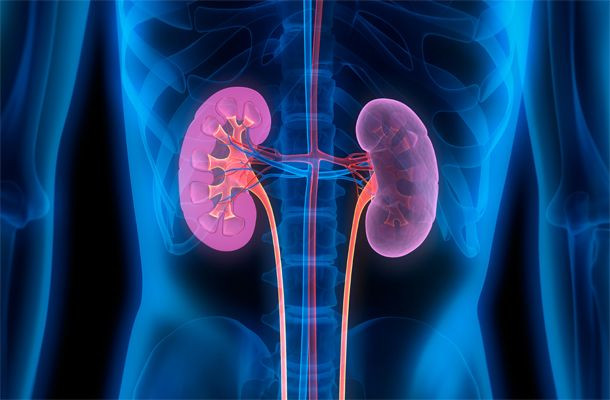Definisi
Batu ginjal, biasa juga disebut sebagai nefrolitiasis atau renal calculi adalah kondisi terbentuknya endapan material keras yang terbuat dari mineral, garam, dan bahan kimia lain dalam ginjal. Ukuran batu ginjal biasanya kecil, tapi bisa semakin membesar dari hari ke hari. Dalam beberapa kasus, batu ini menetap di ginjal dan tidak menimbulkan masalah. Umumnya, batu mulai menimbulkan keluhan dan nyeri hebat saat ukurannya semakin besar. Batu ginjal juga dapat turun ke saluran kemih dan memicu gangguan yang serius.
Batu ginjal adalah gangguan yang paling sering ditemukan pada sistem saluran kemih. Penyakit ini lebih sering dialami oleh pria dan wanita yang berusia antara 20-40 tahun. Walaupun jarang, batu ginjal juga bisa terjadi pada anak-anak. Berbagai jenis batu ginjal mengandung bahan kimia yang berbeda juga, yaitu kalsium oksalat, kalsium fosfat, sistin, struvit, dan asam urat. Penyakit ini juga bisa memiliki kemungkinan untuk kambuh di kemudian hari.
Penyebab
Tidak ada satu penyebab yang pasti dalam terbentuknya batu ginjal, namun diduga batu ginjal bisa terjadi karena kurangnya kandungan air dalam urine. Atau, urine memiliki kandungan mineral seperti kristal kalsium, asam urat, dan fosfat yang lebih banyak dibanding pelarutnya. Batu ginjal juga dapat disebabkan karena adanya kondisi medis seperti:
- Penyakit kista ginjal
- Infeksi saluran kemih
- Gangguan metabolik lainnya
Faktor Risiko
Riwayat Keluarga atau Riwayat Pribadi
Riwayat batu ginjal pada salah satu anggota keluarga Anda, atau bila Anda pernah mengalami batu ginjal sebelumnya, Anda juga berisiko mengalami batu ginjal di kemudian hari.
Kekurangan air
Kurangnya asupan air putih setiap harinya juga dapat meningkatkan risiko batu ginjal untuk mudah terbentuk. Hal ini dikarenakan jumlah urine yang dikeluarkan sedikit.
Pola Makan
Pola makan yang tinggi akan protein, garam, dan gula dapat meningkatkan risiko terkena beberapa tipe batu ginjal. Kebanyakan garam di dalam makanan akan meninggkatkan jumlah kalsium didalam ginjal yang harus disaring dan meningkatkan risiko batu ginjal.
Obesitas
Indeks massa tubuh (IMT) yang tinggi, lingkar pinggang yang besar, dan berat badan yang berlebihan dapat berhubungan dengan peningkatan risiko terbentuknya batu ginjal.
Penyakit Saluran Cerna dan Operasi Tertentu
Operasi bariatrik (prosedur operasi untuk mengecilkan lambung), penyakit radang usus atau diare kronis dapat menyebabkan perubahan pada proses pencernaan yang akan memengaruhi penyerapan air dan kalsium. Hal ini bisa menyebabkan peningkatan risiko terkena batu ginjal.
Suplementasi dan Obat
Suplementasi seperti vitamin C, vitamin D, obat pencahar, dan obat antasida yang mengandung tinggi kalsium dapat meningkatkan risiko terkena batu ginjal.
Gejala
Apabila batu ginjal yang terdapat dalam ginjal berukuran kecil, biasanya tidak akan menimbulkan rasa nyeri atau gejala apapun. Namun, gejala-gejala yang biasa dialami oleh penderita batu ginjal yang besar yakni:
- Nyeri perut bagian bawah dan selangkangan
- Nyeri punggung atau nyeri kolik (nyeri hilang-timbul) yang hebat
- Nyeri hilang timbul antara tulang rusuk dan tulang pinggang yang menjalar ke perut, daerah kemaluan, dan paha bagian dalam
- Mual dan muntah
- Perut menggelembung
- Demam
- Nyeri ketika buang air kecil
- Sulit buang air kecil
- Terdapat darah di dalam urine
Diagnosis
Seperti cara diagnosis penyakit lainnya, dokter akan melakukan wawancara dan pemeriksaan mengenai gejala yang dialami pasien, intensitas nyeri yang dialami, riwayat penyakit pasien dan keluarga, dan riwayat obat-obatan yang sudah dikonsumsi.
Selain itu, dokter juga akan melakukan pemeriksaan fisik berupa memeriksa bagian pinggang, selangkangan, dan perut bagian bawah yang mengalami nyeri.
Kemudian dilakukan juga beberapa pemeriksaan tambahan untuk memastikan diagnosis berupa:
Tes urine
Pemeriksaan urin dilakukan untuk:
- Melihat apakah ada serpihan batu yang terbuang melalui urine
- Mengidentifikasi jenis batu ginjal
- Mendeteksi adanya infeksi saluran kemih
Tes darah
Pemeriksaan darah dibutuhkan untuk:
- Mengetahui apakah ginjal berfungsi dengan baik atau tidak
- Memeriksa adanya zat tertentu yang berpotensi menyebabkan terbentuknya batu ginjal
Pemeriksaan radiologi dan pencitraan
Berbagai pemeriksaan radiologi dan pencitraan dapat dilakukan untuk mengonfirmasi diagnosis serta menentukan posisi batu ginjal secara akurat. Jenis pemeriksaan pencitraan yang dapat dilakukan adalah:
- CT Scan
- Pemeriksaan sinar X atau rontgen
- Ultrasonografi (USG)
- Blass Nier Overzicht Intravenous Pyelogram (BNO – IVP), pemeriksaan pencitraan saluran kemih dengan bantuan zat kontras
Analisis batu ginjal
Analisis batu ginjal dilakukan ketika proses pengangkatan batu dengan operasi dilakukan oleh dokter spesialis urologi yang bertanggung jawab. Informasi analisis batu dapat membantu dokter untuk memutuskan cara terbaik mencegah terbentuknya batu di masa yang akan datang.
Tata Laksana
Terdapat beberapa jenis terapi yang dapat dilakukan untuk batu ginjal, dokter akan memutuskan bergantung dari keparahan batu ginjal yang dialami.
Batu ginjal berukuran kecil
Dokter akan memberikan obat pereda nyeri ketika Anda mengeluarkan batu melalui saluran kemih. Tidak diperlukan terapi khusus, namun Anda disarankan untuk mencukupi asupan cairan dan banyak minum air putih agar batu dapat luruh melalui urin.
Batu ginjal berukuran besar
- Pengobatan
Resep obat akan diberikan untuk membantu memecahkan batu ginjal Anda, namun pilihan terapi ini akan bergantung dengan jenis batu ginjal Anda. Tidak semua batu ginjal yang berukuran besar dapat dihilangkan hanya dengan obat saja.
- Extracorporeal Shock Wave Lithotripsy (ESWL)
Prosedur ini bersifat non-invasif, yakni tidak memerlukan tindakan pembedahan. Dokter akan menggunakan laser atau gelombang kejut yang dipaparkan ke tubuh untuk memecahkan dan menghancurkan batu ginjal. Diharapkan batu ginjal dapat luruh melalui urine pada beberapa hari setelahnya.
- Percutaneous Nephrolithotripsy (PCNL)
Tindakan pembedahan yang dilakukan dengan membuat sayatan kecil pada punggung. Akan dimasukkan selang tipis dengan lensa pembesar (nephroscope) ke dalam ginjal untuk melihat ginjal dan membantu mengangkat batu ginjal.
- Uretero-Renoscopy (URS)
Tindakan pembedahan dimana alat endoskop dimasukkan melalui uretra ke dalam kandung kemih untuk memecahkan dan mengangkat batu ginjal.
Komplikasi
Komplikasi dapat terjadi terutama pada batu ginjal yang berukuran besar, di antaranya:
- Infeksi saluran kemih
- Infeksi ginjal
- Tersumbatnya saluran ureter (saluran yang menghubungkan antara ginjal dengan kandung kemih)
- Pembengkakan ginjal
- Urine berdarah
- Nyeri hebat
- Kerusakan ginjal
Pencegahan
Penyakit batu ginjal dapat dicegah dengan melakukan hal dibawah ini:
- Minum air putih yang cukup setiap hari
- Jangan membatasi makanan yang mengandung kalsium, asupan kalsium yang rendah berisiko mengalami batu ginjal
- Memilih makanan yang rendah garam dan protein hewani
- Menghindari stres
- Menjaga berat badan yang sehat dengan target IMT 18-35 kg/m2
- Berolahraga rutin sebanyak 2-3 kali seminggu
- Mengonsumsi obat-obatan yang diresepkan oleh dokter. Biasanya langkah ini dianjurkan untuk mencegah kambuh bagi mereka yang sebelumnya pernah menderita batu ginjal
Kapan Harus ke Dokter?
Buatlah janji dengan dokter bila Anda mengalami gejala seperti:
- Terdapat darah dalam urine
- Sulit buang air kecil
- Nyeri yang sangat hebat hingga sulit duduk
- Nyeri disertai mual muntah
- Nyeri disertai demam dan menggigil.
Mau tahu informasi seputar penyakit lainnya? Cek di sini, ya!
- dr Hanifa Rahma
Kidney and Ureteral Stones Patient Information - European Association of Urology (2020). Retrieved 18 July 2022, from https://patients.uroweb.org/wp-content/uploads/2018/12/PI_Kidney-and-Ureteral-Stones-EN-Q1-2020-1.pdf
Mayoclinic - Kidney Stones (2022). Retrieved 18 July 2022, from https://www.mayoclinic.org/diseases-conditions/kidney-stones/symptoms-causes/syc-20355755
Urology Care Foundation Kidney Stones Patient Guide (2020). Retrieved 18 July 2022, from https://www.urologyhealth.org/educational-resources/kidney-stones











